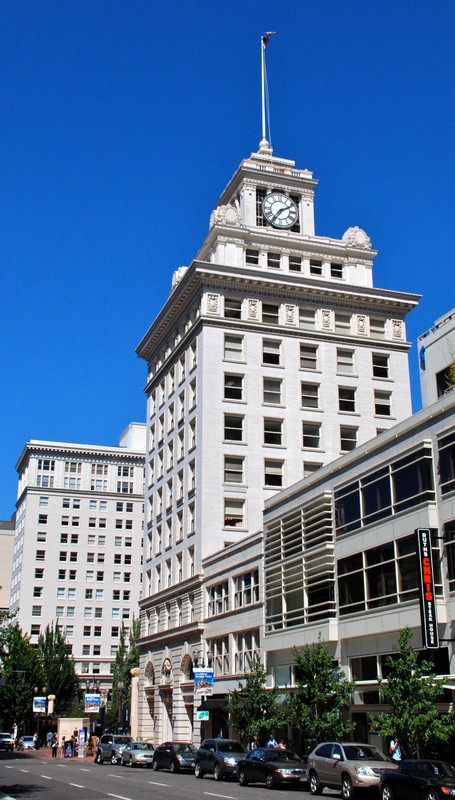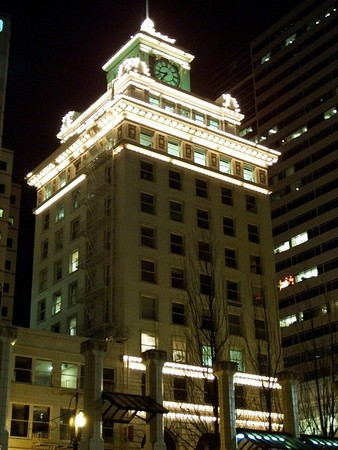The Jackson Tower Building
Introduction
Text-to-speech Audio
Named for Charles Jackson, the founder of the building's original tenant, the now defunt Oregon Journal, the building opened its doors in 1912. The newspaper remained in the building until 1948, when it moved to larger quarters -- the former Portland Public Market building on the Portland waterfront. The building's most striking feature is the impressive clock tower, a common feature of newspaper buildings of the early 20th century.
Images
Source: By Steve Morgan: Wikimedia Commons

Source: https://structurae.net/structures/jackson-tower

Backstory and Context
Text-to-speech Audio
The Jackson Tower, circa 1912, harken back to an era when the newspaper industry enjoyed tremendous popularity. During the decades leading up to, and after, the turn of the 20th, in major cities and frontier lands, written in English and foreign languages for immigrants, newspaper companies appeared in droves. One of those papers, the Oregon Journal, built what became known as the Jackson Tower.
On July 23, 1902, Sam Jackson purchased the rights to the Portland Evening Journal and merged it with a paper he already managed, the East Oregonian. He subsequently changed the name of the entire operation to the Oregon Journal. As per the norm in the early 20th century, newspapers engaged in competition with other publications Jackson's paper competed with the Oregonian and the Telegram.
The paper's front page, on October 22, 1911, reported its own plans to build the Journal Building (now known as Jackson Tower). One attractive feature involved a two-story-deep basement that housed high-speed presses viewable by onlookers walking by the building; the pressed printed nearly 72,000 newspapers per hour. The Oregon Journal obtained the building permit on December 13, 1911 and by August 19, 1912, the newspaper published its first edition from the new home.
The 1905 Lewis & Clark Exposition had a profound effect on Portland's rise from frontier city to a major metropolis, but it also affected the city's architectural style. The Journal Building employed some of the features emanating from that exposition, notably the use of more than 2,400 25-watt light bulbs to illuminate the building. The most striking visual element to the outside decor involved the large clock tower that rang bells on each quarter hour. The clock remained mechanically operated until 1922 when the Standard Electric Time Company electrified the clock.
The newspaper remained in the building until 1948, when it moved to the larger Public Market Building located near the waterfront, though the building remained the property of the Oregon Journal. In 1951, the building was named Jackson Tower after its founder, C. S. Jackson. However, on July 1, 1958, the Jackson family sold the building to Theodore Bruno who modernized the building, investing over $300,000 in improvements. The renovations to Jackson Tower included updated tenant spaces, a newly designed lobby, a steam-cleaned exterior, and the construction of a 100-car garage in the basement, as well as the installation of high-speed elevators.
The 1970s saw changes to both the building and the newspaper -- the building was sold twice, as was the paper. The building went through several changes and updates throughout the 20th century, but the paper folded in the mid-1980s. The building reminds us all of a time when print newspapers were incredibly influential in American culture -- it was the heyday of print journalism. Today's era is much different, so one can only imagine what is being constructed today that will remains standing in 2117 as a reminder of the current digital news era.
Sources
Foreign Language Press Survey. Accessed May 09, 2017. http://flps.newberry.org/.
Nord, David Paul. Communities of Journalism: A History of American Newspapers and Their Readers. Champaign, Illinois: University of Illinois Press, 2006.
Tess, John M. "Registration Form." Published November 15, 1995. National Park Service: National Register of HIstoric Places. https://npgallery.nps.gov/pdfhost/docs/NRHP/Text/96000995.pdf
